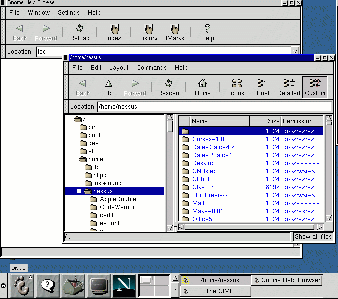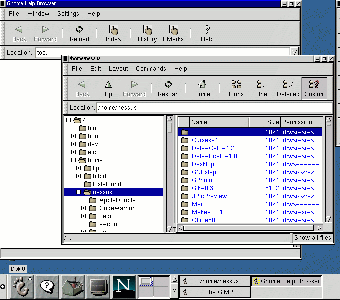Graphic Environment - KDE, GNOME, and Enlightenment
As I mentioned in my previous article, I was very much impressed with
KDE, the K Desktop Environment. This opinion
has not changed. As shipped, it's not particularly flashy, but it does the
job of handling the desktop environment quite well. It's robust and performs
at reasonable speeds, even on my 133 MHz Pentium.
In version 6.0, RedHat also included GNOME,
the GNU
Network Object Model Environment. GNOME ,
with its window manager (Enlightenment)
is supposed to be the Next Great Thing, with lots of really nice features.
In general, I found GNOME and Enlightenment
to be quick and responsive to mouse clicks.
I liked GNOME's file manager very much; it lets you sort file lists in
case-insensitive alphabetical order,
which is what most normal folks are used to.
|
The hype had
led me to believe that Enlightenment was “it.”
Visually, Enlightenment is one of the more attractive window managers I've seen,
and it certainly has a large number of features and options for customizing
the display.
(See the screen shot at the right, which shows some of the options you have
for displaying a window as it is moved. Click the picture for a full-size
view.) But does having these options make the system any easier for a
beginning user? I don't see how.
|

|

|
As I see it, Enlightenment's authors appear to have concentrated more
on visual power and beauty than on ease of use. For example, examine the
screen shot at the left. (Click the picture for a full-size view). See the
GNOME pager, which consists of those
rectangular buttons near the lower right? They tell you which windows
are currently available on your desktop. The one that looks like it's pushed
corresponds to the window that's currently in front, /home/nessus.
|

|
In the K Desktop Environment, clicking the button corresponding to another
window brings that window to the top and gives it the “focus”
(its title bar turns blue and you can type in it). This is also how
it works in the system-from-Redmond. On the Macintosh, when you select an
application from the menu at the top right of the screen, it also brings
that application's window to the front as it activates it. In Enlightenment,
however, it simply activates the window -- without bringing it to the front!
To bring it to the front, you either have to move up and click the title
bar (which, presumably, you didn't do in the first place because the mouse was
closer to the bottom of the screen) or you have to press CTRL-ALT-up arrow
to “raise” the window.
I searched around for quite some time, but couldn't figure out how to bring the
window to the front when I clicked on its rectangle at the bottom. I always
needed an extra click or keypress to bring the window to the front.
|
If this isn't just a bug that somehow avoided the eyes of the testers, then
I have to seriously question its design. I can't think of any instance where I'd
want an active window that was partially (or totally) obscured by an inactive one.
In any case, it should not be the default behavior; it requires extra
work on the user's part and is at odds with the expectations set by several
other GUIs and window managers.
The small annoyance of having to do “double work” became a major
annoyance for me when it happened often enough during a working day.